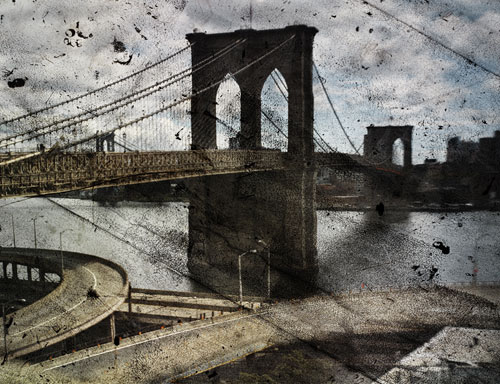I am a big fan of Abelardo Morell's work, particulary his Camera Obscura series (shown here and here). His two new bodies of work - Tent Work and Cliché Verre - are on show at the Bonni Benrubi Gallery in New York until 18 Dec 2010.
In his tent-camera
process Morell continues to push the boundaries of the way we
see with the use of a lightproof tent and periscope that allows him to project
a view of the nearby landscape directly onto the ground below. The resulting
photographs play on the tropes of impressionistic painting as the projected
landscapes are refracted on the grass, sand or pavement below.
"Recently, I began to wonder what it would be like to marry images of landscapes with the surface of the ground nearby. I have worked with my assistant, C.J. Heyliger, on designing a light proof tent that, via periscope type optics, makes it possible to project a view of the nearby landscape onto whatever ground is under the tent. Inside this darkened space I use a view camera to record the effect, which I think is a rather wonderful sandwich of two outdoor realities coming together. This Tent-Camera now liberates me to use camera obscura techniques in a world of new places. I now have a portable room, so to speak." - Abelardo Morell

Abelardo Morell
Tent-Camera Image on Ground: Rooftop View of the Brooklyn Bridge, 2010
"Cliché Verre" is a series of photographs of ferns and cycads. Cliché Verre means "glass picture," and was used by the French painters Corot and Millet. Morell has literally pressed several plants repeatedly all over the surface of a glass plate to achieve more complex imagery, which can look like imaginary jungles or forests.
Press release here: |
October 7- December 18, 2010
Bonni Benrubi Gallery is pleased to announce an exhibition of new work by photographer Abelardo Morell.
GROUNDWORK will present work from Morell's innovative tent-camera process. Morell continues to push the boundaries of the way we see with the use of a lightproof tent and periscope that allows him to project a view of the nearby landscape directly onto the ground below. The resulting photographs play on the tropes of impressionistic painting as the projected landscapes are refracted on the grass, sand or pavement below.
In his latest work, Morell continues to push the boundaries of post modernity as he travels to Italy, positioning his tent on the historic cobblestones of Rome and Florence and entering into the Villa Medici. In one image, his tent cum camera obscura inhabits the same space and spirit of Brunelleschi as he famously painted the Florentine Baptistery circa 1425 in the first known demonstration of optical linear perspective, created with the aid of a pinhole drilled in a mirror. Morell's tent and traditional camera obscura images of Italy, including that of the Baptistery, serve not, however, as dry linear truths, but rather fluid juxtapositions imbued with the same sense of discovery, magic and wonder that powered the Renaissance. Morell again proves that the simple, yet elusive, combination of serendipity, innovation and humanity offers the greatest wealth of artistic possibilities.
In the "Blue Room" will be a separate exhibition of Cliché Verre photographs of ferns and cycads. Morell created this body of work for The Island of Rota, a limited edition publication by the Museum of Modern Art in New York featuring the writing of Oliver Sacks and the design of Ted Muehling. Cliché Verre means "glass picture," and was used by the French painters Corot and Millet. It is basically a hand drawn negative. Morell has literally pressed several plants repeatedly all over the surface of a glass plate to achieve more complex imagery, which at times look like imaginary dense jungles or forests.
Abelardo Morell received his MFA from Yale University and was a professor at the Massachusetts College of Art. His photographs are contained in some of the most important private and museum collections around the world. He has had eight books of his photographs published to date. A major retrospective, jointly organized by the Art Institute of Chicago and The Getty Museum, is projected to open in 2013, and will travel to other major venues.
For further information or press inquiries, please contact the Bonni Benrubi Gallery.

Leave a comment